The name “L.C. Pike” is written on the back of this carte-de-visite. Generally a name on the back of a portrait refers to the sitter, but not always, so it’s important to try to find corroborating information. I searched on Ancestry for an L.C. Pike who was about forty years old in the early 1860s and living in Cork, Ireland. Only one came up, so I’m optimistic she may be the right person.
Lydia Clibborn Pike was born into a Quaker family in September 1821 in historic County Tyrone, in what is today Northern Ireland. She married Ebenezer Pike (not a close relation) in Cork when she was nineteen years old and he was almost 35. They were married 42 years, until his death in 1883. They had at least nine children who survived to adulthood. She died at the age of 88, in March 1900, in Bessborough, County Cork.
The photograph was taken at the studio of Edward J. Harding & Son, Portrait Painters & Photographists. Edward J. Harding (1804-1870) is listed as a “Portrait Painter” in A Dictionary of Irish Artists (1913).

This is my first blog post featuring a portrait from Ireland. After more than a year, the blog has yet to receive a visitor from the Emerald Isle. I do hope Lydia Clibborn will change that.

Update on June 5: I’ve zoomed in on the flower and fern, below. I hadn’t noticed the fern until it was pointed out by astute visitors yesterday!

I also zoomed in as far as possible on the ring hanging at the end of the chain. There does appear to be something else attached to the ring … maybe a key?
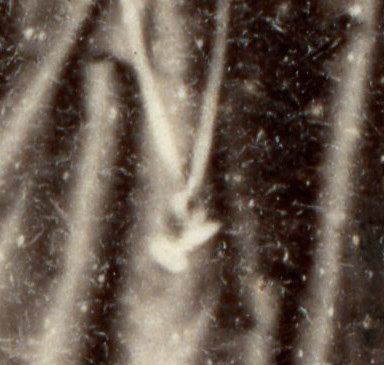
Finally, I’m pleased to report that the blog received its first visitor from Ireland (Éire) yesterday, after this post was published.
Page last updated: May 11, 2020. (She had at least nine children who survived to adulthood, rather than eight.)

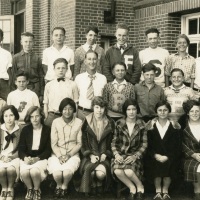



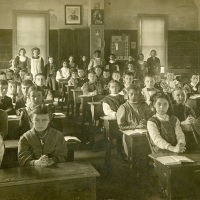

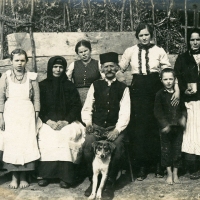
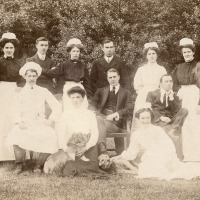
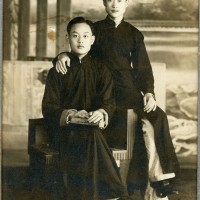
How great to see an early Irish photograph. I actually had a viewer from Ireland to my photographers site today but it is rather a rare occurrence. Also, my own collection of cdv photos is quite small and I wonder if famine and mass emigration played some part in this. Dublin had lots of photographers (19th century) but that was far and away the biggest city in the country.
LikeLiked by 2 people
Thank you, Christine! I see so many photos for sale in the UK (on eBay), but few are from Ireland. I’ve noticed one or two dealers in Ireland but haven’t bought from them. You mention famine and emigration. I’ve also wondered if poverty might have been a factor preventing many families from buying portraits. This carte came from a dealer in Wales (Llanwrtyd Wells). I have no idea how it ended up there. Of course, dealers travel and buy from each other all the time, so older photos get shuffled around and connections to families get lost.
LikeLiked by 1 person
Interesting. 🙂 I would never have known that letter was a P. That might help me identify something in a card I bought recently (if I can remember which photo it is… how odd that I remember the writing more than the image!)
Try using Eire as a tag as well as or instead of Ireland. That might attract more people from there. Normally when we think of Ireland in this part of the world, we think of Northern Ireland, and of the south part separately as Eire.
Wales is fairly close to Eire, as the crow flies (though it might have to swim some of the way!)
LikeLiked by 2 people
Great suggestion! I wouldn’t have thought of using Eire as a tag. Here in the States it’s fashionable to claim some Irish ancestry, but many who have a little (like me) know nothing about those ancestors. Mine probably came over during the famine, but I don’t know what part of the island they came from. The census records just say they were born in Ireland.
LikeLiked by 1 person
I’d agree that poverty would be the answer to the rarity of Irish CDV and other forms of old photography, not to mention a small population.
Brad, do you think she is holding a fern and a flower – I’m not sure if the fern is part of the deterioration of the image? Do you know if their is any symbolic significance to that if they are fer and flower? I love her exceedingly long chain. It appears to have a ring on it. It is a lovely rare image.
LikeLiked by 1 person
The length of the chain is unusual, isn’t it? And I’d love to know what the significance is of the flower and fern, if any. You have an eagle eye! 😉
LikeLiked by 1 person
Just doin’ me job, boss! 😆
I’m going to have a google and see if it has any meaning. . .
LikeLiked by 1 person
Maiden hair fern (which is the type of fern I believe she is holding), means a secret bond of love and the pansy, which is kind of a random guess at the flower, means loving feelings.
LikeLiked by 1 person
I also meant to let you know that I’ve added some detail images at the end of the post, if you’d like to take another look. Thank you!
LikeLiked by 1 person
Didn’t find this comment until after replying to another, dammit. The detail images are great! I don’t think the flower is a pansy, now. Maybe a fully opened rose? I bet roses mean lovey dovey things, too. . . Yep! The type of love is symbolised through the colour of the rose, apparently.
LikeLiked by 1 person
I think she’s holding a fern and a flower, and I think her chain has something else on it as there’s something dark hanging level with the flower she’s holding. I love how her waist is accentuated and the details on the edge of the sleeves, although they must have been terribly impractical (like the rest of her dress!)
LikeLiked by 2 people
I also find her wide sleeves beautiful, if impractical. I examined the dark mark you mentioned, and it looks like a flaw in the emulsion (printing), rather than something she’s wearing. Regarding the objects hanging at the end of the chain, I’ve added a detail image at the end of the post which helps. Thanks for your comment!
LikeLiked by 1 person
Very interesting photo. May it be a Claddagh ring?
LikeLike
Hmm, interesting idea. The design looks different, but you’re thinking creatively, which is good. 😉 We need to figure out why she’s wearing it on such a long chain.
LikeLike
It can be a family jewel (her mother or grandmother).
In some reasons, the ring could be removed from the left hand and put on the right hand, or worn on a chain instead of the right hand.
LikeLiked by 1 person
I really enjoy your posts on these old, old photographs. What a great topic for a blog. And, I had no idea that there were Quakers in Ireland!
LikeLiked by 1 person
Thanks so much, Jadi! I didn’t know there were Quakers in Ireland, either. I should probably do more research for each post, but it’s very easy to get carried away, and then the post takes forever to put together. I enjoy the variety of topics on your blog and your lighthearted tone. Your most recent post–about throwing out your back–was painful to read, but the humor made it seem alright in the end. I hope that’s true! Even if it means you can’t be Superwoman anymore.
LikeLike
Thank you for an entertaining first year. Here’s to a great New Year and more fascinating images.
LikeLiked by 1 person
It’s always nice to hear from you, Christine! You have a wonderful collection!
LikeLike
I am a descendant of EJ Harding and recognize the the design of the back of the photo. It is the same design he used as that on the back of his calling card (business card). The card is oval with his photo-portrait on the front.
If you happen to have an Ancestry.com account, you should be able to see his visage here: https://www.ancestry.com/family-tree/tree/152937681/family?cfpid=132027073231.
I’m actually fairly clueless (not for lack of trying!) as to where he grew up (presumably) in County Cork, or who his mother or siblings were.
I know the chances are slim; but If anyone should see any of his family history info connected with any of his works, please let me know by replying to this comment.
TIA!
John James
Seattle, USA
LikeLiked by 2 people
John, thanks for your comment! I’ll keep an eye out for information about E.J. Harding. I rarely see photos by him for sale–maybe two or three in the last five years. But you never know what will turn up, and much of the written history of photography isn’t on the internet (yet). Regards from Vermont, Brad Purinton
LikeLiked by 1 person
Brad,
A belated Thanks! Nice to know other eyes are on the lookuout for the works of my g g g grandfather.
John
LikeLiked by 1 person
Hi John James,
I just bought this miniature of your ancestor in auction. He was a portrait miniature painter too. Signed on th back E Harding, South Mall Cork
https://www.the-saleroom.com/en-gb/auction-catalogues/chiswick-auctions/catalogue-id-srchis10786/lot-1b1ac67c-a3d2-4f43-a41a-ace900b30ea4#lotDetails
LikeLiked by 1 person
Hello Karl, thanks for your comment. I couldn’t see the painting on the page you linked to, but I found it on another page here . Congratulations! Edward J. Harding was a very skilled painter. Regards, Brad
LikeLike
Thanks for the reply, yes that’s the one. He was multi-talented person indeed.
LikeLiked by 1 person